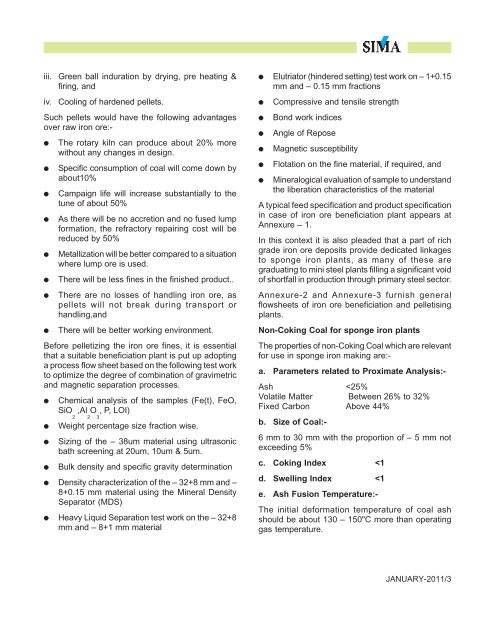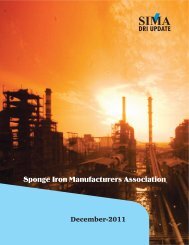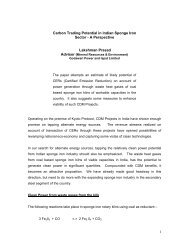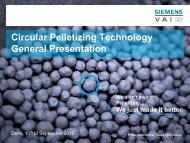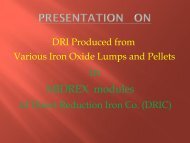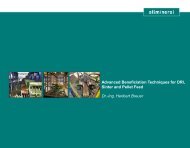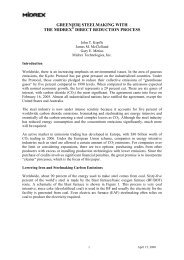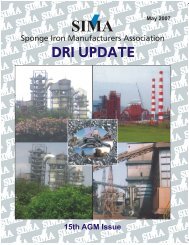sponge iron industry –past-present-future - SIMA
sponge iron industry –past-present-future - SIMA
sponge iron industry –past-present-future - SIMA
You also want an ePaper? Increase the reach of your titles
YUMPU automatically turns print PDFs into web optimized ePapers that Google loves.
iii. Green ball induration by drying, pre heating &<br />
firing, and<br />
iv. Cooling of hardened pellets.<br />
Such pellets would have the following advantages<br />
over raw <strong>iron</strong> ore:-<br />
l The rotary kiln can produce about 20% more<br />
without any changes in design.<br />
l Specific consumption of coal will come down by<br />
about10%<br />
l Campaign life will increase substantially to the<br />
tune of about 50%<br />
l As there will be no accretion and no fused lump<br />
formation, the refractory repairing cost will be<br />
reduced by 50%<br />
l Metallization will be better compared to a situation<br />
where lump ore is used.<br />
l There will be less fines in the finished product..<br />
l There are no losses of handling <strong>iron</strong> ore, as<br />
pellets will not break during transport or<br />
handling,and<br />
l There will be better working env<strong>iron</strong>ment.<br />
Before pelletizing the <strong>iron</strong> ore fines, it is essential<br />
that a suitable beneficiation plant is put up adopting<br />
a process flow sheet based on the following test work<br />
to optimize the degree of combination of gravimetric<br />
and magnetic separation processes.<br />
l Chemical analysis of the samples (Fe(t), FeO,<br />
, P, LOI)<br />
SiO ,Al O<br />
2 2 3<br />
l Weight percentage size fraction wise.<br />
l Sizing of the – 38um material using ultrasonic<br />
bath screening at 20um, 10um & 5um.<br />
l Bulk density and specific gravity determination<br />
l Density characterization of the – 32+8 mm and –<br />
8+0.15 mm material using the Mineral Density<br />
Separator (MDS)<br />
l Heavy Liquid Separation test work on the – 32+8<br />
mm and – 8+1 mm material<br />
l Elutriator (hindered setting) test work on – 1+0.15<br />
mm and – 0.15 mm fractions<br />
l Compressive and tensile strength<br />
l Bond work indices<br />
l Angle of Repose<br />
l Magnetic susceptibility<br />
l Flotation on the fine material, if required, and<br />
l Mineralogical evaluation of sample to understand<br />
the liberation characteristics of the material<br />
A typical feed specification and product specification<br />
in case of <strong>iron</strong> ore beneficiation plant appears at<br />
Annexure – 1.<br />
In this context it is also pleaded that a part of rich<br />
grade <strong>iron</strong> ore deposits provide dedicated linkages<br />
to <strong>sponge</strong> <strong>iron</strong> plants, as many of these are<br />
graduating to mini steel plants filling a significant void<br />
of shortfall in production through primary steel sector.<br />
Annexure-2 and Annexure-3 furnish general<br />
flowsheets of <strong>iron</strong> ore beneficiation and pelletising<br />
plants.<br />
Non-Coking Coal for <strong>sponge</strong> <strong>iron</strong> plants<br />
The properties of non-Coking Coal which are relevant<br />
for use in <strong>sponge</strong> <strong>iron</strong> making are:-<br />
a. Parameters related to Proximate Analysis:-<br />
Ash


